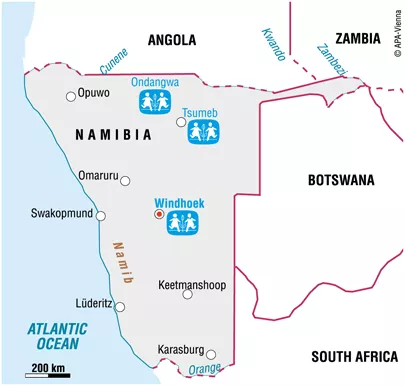
Many vulnerable children and young people who have lost parental care are supported by Namibia's SOS Children's Villages.
Our organisation helps them to grow up in a caring family environment. Since the war in neighbouring Angola caused mass-immigration into Namibia, the presence of our organisation in Namibia has become even more necessary.
At present there are three SOS Children's Villages, three SOS Youth Facilities, three SOS Kindergartens, one SOS Hermann Gmeiner School and three SOS Social Centres (family strengthening programmes) in Namibia. The Republic of Namibia is a large and sparsely populated country in South-West Africa. The total population of Namibia is approximately 2 million and its capital city is Windhoek, home to 340,000.
Please help us ensure a loving home for every child. Sponsor a child in Africa now.
For just $36/month you can sponsor a child and help provide an orphaned or abandoned child with:
- A safe and nurturing home
- A loving SOS mother
- Quality education
- Healthcare
- Nutritious food
- Clothing and toys
- All the things necessary for a bright future
SOS Children's Villages in Namibia
In 1990, Namibia became an independent nation. Since then, it has enjoyed relative stability. Namibia is a middle-income country with a market economy that is driven by the following sectors: agriculture, mining, fishing and tourism.

Malnutrition and diseases take their toll
Malnourishment, particularly among children, remains a persistent problem: 20 per cent of the Namibian population lack access to food and are chronically undernourished. Malnutrition is directly responsible for the death of at least 6,000 children annually. Frequent droughts and floods aggravate the situation, especially in extremely arid, rural areas of the country.
Furthermore, Namibia is marked by a very high number of HIV/AIDS infections. At 13 per cent, the HIV prevalence rate is one of the highest in the entire world. Apart from the social implications of HIV, the disease is becoming an economic problem too: the most productive age group (25-44 years) also accounts for the highest number of HIV infections.
Although the government of Namibia has made the fight against AIDS a national priority, 6,700 people die every year due to the disease. However, AIDS is not the only health risk that affects Namibians: other common diseases in Namibia include hepatitis A, typhoid fever and malaria.
Although access to potable water is generally good in urban areas, Namibians who live in rural parts of the country often experience fluctuating levels of water supply.
Like in most other Sub-Saharan countries, poverty is a problem in Namibia: more than 39 per cent of the population are considered poor by UN standards.
The total school enrolment ratio for Namibia is roughly 89 per cent.
Situation of the children in Namibia
Demographically speaking, Namibia is a very young country: nearly 35 per cent of the country's population is under 14 years of age. This figure can partly be attributed to the fact that Namibia has a comparatively low life expectancy.
The current estimate is that Namibia is home to around 140,000 orphans. 70,000 of them have been orphaned because of AIDS. Children who lose their parents due to HIV often lack a caring family environment. In many cases, their most basic needs are not met and they are vulnerable to commercial sexual exploitation and forced labour in the streets of Namibia's cities.
In Namibia, there are many street children. During the day, they beg for money and food or they do small jobs in order to survive. Many of them sleep in little shacks, in river beds or under bridges.
Female headed households account for nearly half of the overall number of households in the country, primarily owing to the low life expectancy of males and labour migration.
The income situation in female-headed families is often precarious. In fact, they account for the highest share of poor households in the country. It is evident that young children who grow up within these families are more likely to be disadvantaged throughout childhood than other children who grow up with both parents still alive.
Young boys and girls are often in charge of putting food on the table for an entire family. Consequently, many of them do not attend school and there is not much time left for social or recreational activities.
Hunger and starvation are serious problems that affect Namibia's youngest segment of population more than any other: the country is marked by nearly twice the normal percentage of moderately stunted children and three times that of severely stunted ones.
In Namibia, the situation remains serious: the prevalence of undernourishment in children under the age of five is high at roughly 18 per cent. At 27 per cent, it is even higher among orphaned children and children who grow up without parental care.
Our Impact
Image
The SOS Children's Village in Namibia provides loving homes to orphaned and abandoned children |
3 VILLAGES | 243 Orphaned and Abandoned Children |
Image
The SOS Youth Facilities in Namibia provides youth with a loving environment where they learn to transition into independent living and to expand their education |
4 YOUTH FACILITIES | 48 Youths in our Care |
Image

The SOS Kindergarten in Namibia are a fundamental building block for the early development needs including, intellectual and social skills for children. |
3 KINDERGARTENS | 205 Kindergarten students |
Image

SOS Social Centres in Namibia aim is to help families, in particular women and children, living in communities neighbouring the SOS Children's Villages to gradually escape from poverty, and to help young people become self-reliant. |
3 SOCIAL CENTRES | 1498 Beneficiaries |
Our Impact






